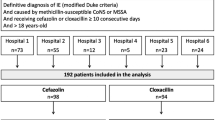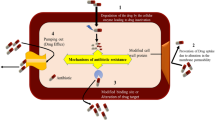Summary
In order to investigate the clinical and microbiological characteristics of patients with complicated intra-abdominal infections (cIAIs) in intensive care unit (ICU), the clinical data of 612 cIAIs patients from January 2016 to December 2018 were retrospectively collected. Clinical characteristics, distribution of pathogens and drug resistance were statistically analyzed. It was found that patients with community-acquired intra-abdominal infections (CA-IAIs) made up a majority of cIAIs patients. The positive rate of abdominal drainage fluid culture was 55.56%. Gramnegative bacteria accounted for the majority, the most commonly isolated bacteria of which were Escherichia coli (20.96%), Klebsiella pneumoniae (10.20%) and Pseudomonas aeruginosa (5.57%). The most commonly isolated gram-positive bacteria were Enterococcus (16.88%) and Methicillin-resistant staphylococcus aureus (MRSA, 3.90%). Enterobacter isolates showed high resistance rate to most cephalosporins and low resistance rate to piperacillin/tazobactam and carbapenems. Extended spectrum beta-lactamase (ESBL) screen positive isolates from CA-IAIs patients showed an increasing trend in past three years. Enterococcus and MRSA showed high resistance rate to clindamycin, quinolone, erythromycin and tetracycline, while they showed high sensitivity rate to linezolid, tegacycline, teicoplanin and vancomycin. Our results indicate that isolated bacteria from abdominal drainage fluid show high resistance rates to commonly used antibiotics in ICU patients with cIAIs. The curative effects on diseases should be monitored continuously when antibiotics are used. Meanwhile, we should always keep eyes on drug-resistant bacteria, especially when the treatment efficacy is not good.
Similar content being viewed by others
References
De Waele J, Lipman J, Sakr Y, et al. Abdominal infections in the intensive care unit: characteristics, treatment and determinants of outcome. BMC Infect Dis, 2014,14:420
Friedrich AK, Cahan M. Intraabdominal infections in the intensive care unit. J Intensive Care Med, 2014,29(5):247–254
Sartelli M, Catena F, Ansaloni L, et al. Complicated intra-abdominal infections worldwide: the definitive data of the CIAOW Study. World J Emerg Surg, 2014,9:37
Singer M, Deutschman CS, Seymour CW, et al. The Third International Consensus Definitions for Sepsis and Septic Shock (Sepsis-3). JAMA, 2016,315(8):801–810
Sartelli M, Chichom-Mefire A, Labricciosa FM, et al. The management of intra-abdominal infections from a global perspective:2017 WSES guidelines for management of intra-abdominal infections. World J Emerg Surg, 2017,12:29
Solomkin JS, Mazuski JE, Bradley JS, et al. Diagnosis and management of complicated intra-abdominal infection in adults and children: guidelines by the Surgical Infection Society and the Infectious Diseases Society of America. Surg Infect (Larchmt), 2010,11(1):79–109
Sartelli M, Weber DG, Ruppe E, et al. Antimicrobials: a global alliance for optimizing their rational use in intraabdominal infections (AGORA). World J Emerg Surg, 2016,11:33
Kurup A, Liau KH, Ren J, et al. Antibiotic management of complicated intra-abdominal infections in adults: The Asian perspective. Ann Med Surg (Lond), 2014,3(3):85–91
Chang YT, Coombs G, Ling T, et al. Epidemiology and trends in the antibiotic susceptibilities of Gram-negative bacilli isolated from patients with intra-abdominal infections in the Asia-Pacific region, 2010–2013. Int J Antimicrob Agents, 2017,49(6):734–739
De Pascale G, Carelli S, Vallecoccia MS, et al. Risk factors for mortality and cost implications of complicated intra-abdominal infections in critically ill patients. J Crit Care, 2019,50:169–176
White BP, Wagner JL, Barber KE, et al. Risk Factors for Failure in Complicated Intraabdominal Infections. South Med J, 2018,111(2):125–132
Zhang H, Yang Q, Liao K, et al. Update of incidence and antimicrobial susceptibility trends of Escherichia coli and Klebsiella pneumoniae isolates from Chinese intra-abdominal infection patients. BMC Infect Dis, 2017,17(1):776
Zhang H, Johnson A, Zhang G, et al. Susceptibilities of Gram-negative bacilli from hospital- and community-acquired intra-abdominal and urinary tract infections: a 2016–2017 update of the Chinese SMART study. Infect Drug Resist, 2019,12:905–914
Zhang H, Yang Q, Liao K, et al. Antimicrobial Susceptibilities of Aerobic and Facultative GramNegative Bacilli from Intra-abdominal Infections in Patients from Seven Regions in China in 2012 and 2013. Antimicrob Agents Chemother, 2016,60(1):245–251
Bouxom H, Fournier D, Bouiller K, et al. Which non-carbapenem antibiotics are active against extended-spectrum beta-lactamase-producing Enterobacteriaceae?. Int J Antimicrob Agents, 2018,52(1):100–103
Kerneis S, Valade S, Geri G, et al. Cefoxitin as a carbapenem-sparing antibiotic for infections caused by extended-spectrum beta-lactamase-producing Escherichia coli and Klebsiella pneumoniae. Infect Dis (Lond), 2015,47(11):789–795
Mambie A, Vuotto F, Poitrenaud D, et al. Cefoxitin: An alternative to carbapenems in urinary tract infections due to extended-spectrum beta-lactamase-producing Enterobacteriaceae. Med Mal Infect, 2016,46(4):215–219
Jimenez-Guerra G, Heras-Canas V, Bejar ML, et al. Extended-spectrum beta-lactamase-producing Escherichia coli and Klebsiella pneumoniae from urinary tract infections: Evolution of antimicrobial resistance and treatment options. Med Clin (Barc), 2018,150(7):262–265
Ouyang W, Xue H, Chen Y, et al. Clinical characteristics and antimicrobial patterns in complicated intraabdominal infections: a 6-year epidemiological study in southern China. Int J Antimicrob Agents, 2016,47(3):210–216
Rodriguez-Bano J, Navarro MD, Retamar P, et al. beta-Lactam/beta-lactam inhibitor combinations for the treatment of bacteremia due to extended-spectrum beta-lactamase-producing Escherichia coli: a post hoc analysis of prospective cohorts. Clin Infect Dis, 2012,54(2):167–174
Tamma PD, Han JH, Rock C, et al. Carbapenem therapy is associated with improved survival compared with piperacillin-tazobactam for patients with extended-spectrum beta-lactamase bacteremia. Clin Infect Dis, 2015,60(9):1319–1325
Author information
Authors and Affiliations
Corresponding author
Additional information
Conflict of Interest Statement
The authors declare that they have no competing interest.
This project was supported by gants from Research Foundation of Health and Family Planning Commission of Hubei Province (No. WJ2017M041), National Natural Science Foundation of China (No. 81770283), and Clinical Medical Research Center of Peritoneal Cancer of Wuhan, China (No. 2015060911020462).
Rights and permissions
About this article
Cite this article
Xiong, Ym., Rao, X. Clinical and Microbiological Characteristics of Patients with Complicated Intra-abdominal Infections in Intensive Care Unit. CURR MED SCI 40, 104–109 (2020). https://doi.org/10.1007/s11596-020-2152-x
Received:
Revised:
Published:
Issue Date:
DOI: https://doi.org/10.1007/s11596-020-2152-x




